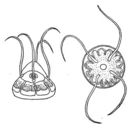Biology
provided by Arctic Ocean Biodiversity 2011
A four tentacled jelly sometimes abundant on Arctic shelves
- license
- cc-by-nc
- copyright
- Arctic Ocean Diversity
- author
- Kevin Raskoff
- author
- Russ Hopcroft
Life Cycle
provided by Arctic Ocean Biodiversity 2011
Holplanktonic, with an identifiable "larval" stage; generation time likely one year, life expectancy unknown
- license
- cc-by-nc
- copyright
- Arctic Ocean Diversity
- author
- Kevin Raskoff
- author
- Russ Hopcroft
Trophic Strategy
provided by Arctic Ocean Biodiversity 2011
Diet is unknown, but other narcomedusae are known to feed primarily on other gelantinous taxa
- license
- cc-by-nc
- copyright
- Arctic Ocean Diversity
- author
- Kevin Raskoff
- author
- Russ Hopcroft
Comprehensive Description
provided by Arctic Ocean Biodiversity 2011
clear translucent; 4 prominent tentacles emerge well above the bell margin; 4 stomach pouches per quadent
- license
- cc-by-nc
- copyright
- Arctic Ocean Diversity
- author
- Kevin Raskoff
- author
- Russ Hopcroft
Habitat
provided by Arctic Ocean Biodiversity 2011
Arctic and sub-arctic; usually found on shelves, less commonly in offshore waters, but no deeper then 500 m; damaged speciemens easily confused with confused with the new species Bathykorus bouilloni which is restricted to deeper waters
- license
- cc-by-nc
- copyright
- Arctic Ocean Diversity
- author
- Kevin Raskoff
- author
- Russ Hopcroft
Biology
provided by EOL Interns LifeDesk
This is a widespread arcto-boreal euro-bathic oceanic species.
- license
- cc-by-nc
- copyright
- Bridges, Lauren
Comprehensive Description
provided by EOL Interns LifeDesk
Aeginidae with 16 stomach pouches; no peripheral canal system; four primary tentacles and eight peronia; no secondary tentacles on the umbrella margin; sensory clubs with no otoporpae.
- license
- cc-by-nc
- copyright
- Bridges, Lauren
Diagnostic Description
provided by EOL Interns LifeDesk
Hemispherical umbrella with thick apical jelly. Broad, lenticular stomach with sixteen rectangular pouches; the eight primary pouches are deeply cleft. Four large primary tentacles issuing from very high level. Eight peronia. Two or three sensory clubs in each octant. Umbrella up to 25 mm wide.
- license
- cc-by-nc
- copyright
- Bridges, Lauren
Distribution
provided by EOL Interns LifeDesk
East Pacific; Western Atlantic Ocean; Arctic Ocean
- license
- cc-by-nc
- copyright
- Bridges, Lauren
Habitat
provided by EOL Interns LifeDesk
Found in cold and less saline waters.
- license
- cc-by-nc
- copyright
- Bridges, Lauren
Description
provided by iArczoo
Common Arctic and sub-Arctic jellyfish. Bell flattened, four tentacles originate from the top of the bell. Body colorless.
- license
- cc-by-3.0
- copyright
- Ershova, Elizaveta
- compiler
- Ershova, Elizaveta
Distribution
provided by iArczoo
Oceanic, Arctic species. Found in all Arctic and sub-Arctic seas.
- license
- cc-by-3.0
- copyright
- Ershova, Elizaveta
- compiler
- Ershova, Elizaveta
Morphology
provided by iArczoo
Body colorless.
Umbrella flattened. Dense tentacles originate from the top surface of the umbrella. The manubrium takes up most of the subumbrella surface, mouth opening round. 16 gastric pouches have small projections toward the outside. Gonads are located on the bottom surface of the gastric pouches; they fuse in their proximal parts and form a continuous ring, which surrounds the central part of the manubrium.
- license
- cc-by-3.0
- copyright
- Ershova, Elizaveta
- compiler
- Ershova, Elizaveta
Size
provided by iArczoo
Diameter 15-20 (sometimes up to 25) mm
- license
- cc-by-3.0
- copyright
- Ershova, Elizaveta
- compiler
- Ershova, Elizaveta
Biology
provided by World Register of Marine Species
direct development
van der Land, J. (ed). (2008). UNESCO-IOC Register of Marine Organisms (URMO).
- license
- cc-by-4.0
- copyright
- WoRMS Editorial Board
Diagnosis
provided by World Register of Marine Species
Aeginopsis medusa up to 25 mm wide, hemispherical or somewhat conical, apex thick, lateral walls very thin. Stomach broad, lenticular; 16 rectangular stomach pouches (eight primary pouches deeply cleft). 4 large primary tentacles issuing at a very high level; 4 perradial and 4 interradial peronia. No peripheral canal system; 2-3 statocysts in each octant.
Wild, H, Drummond, R.B. & Gonçalves, M.L. (1969) 50. Vitaceae Flora de Moçambique Junta de Investigaçoes de Ultramar, Centro de Botanica Page 13
- license
- cc-by-4.0
- copyright
- WoRMS Editorial Board
Habitat
provided by World Register of Marine Species
surface to deep water
Wild, H, Drummond, R.B. & Gonçalves, M.L. (1969) 50. Vitaceae Flora de Moçambique Junta de Investigaçoes de Ultramar, Centro de Botanica Page 13
- license
- cc-by-4.0
- copyright
- WoRMS Editorial Board

